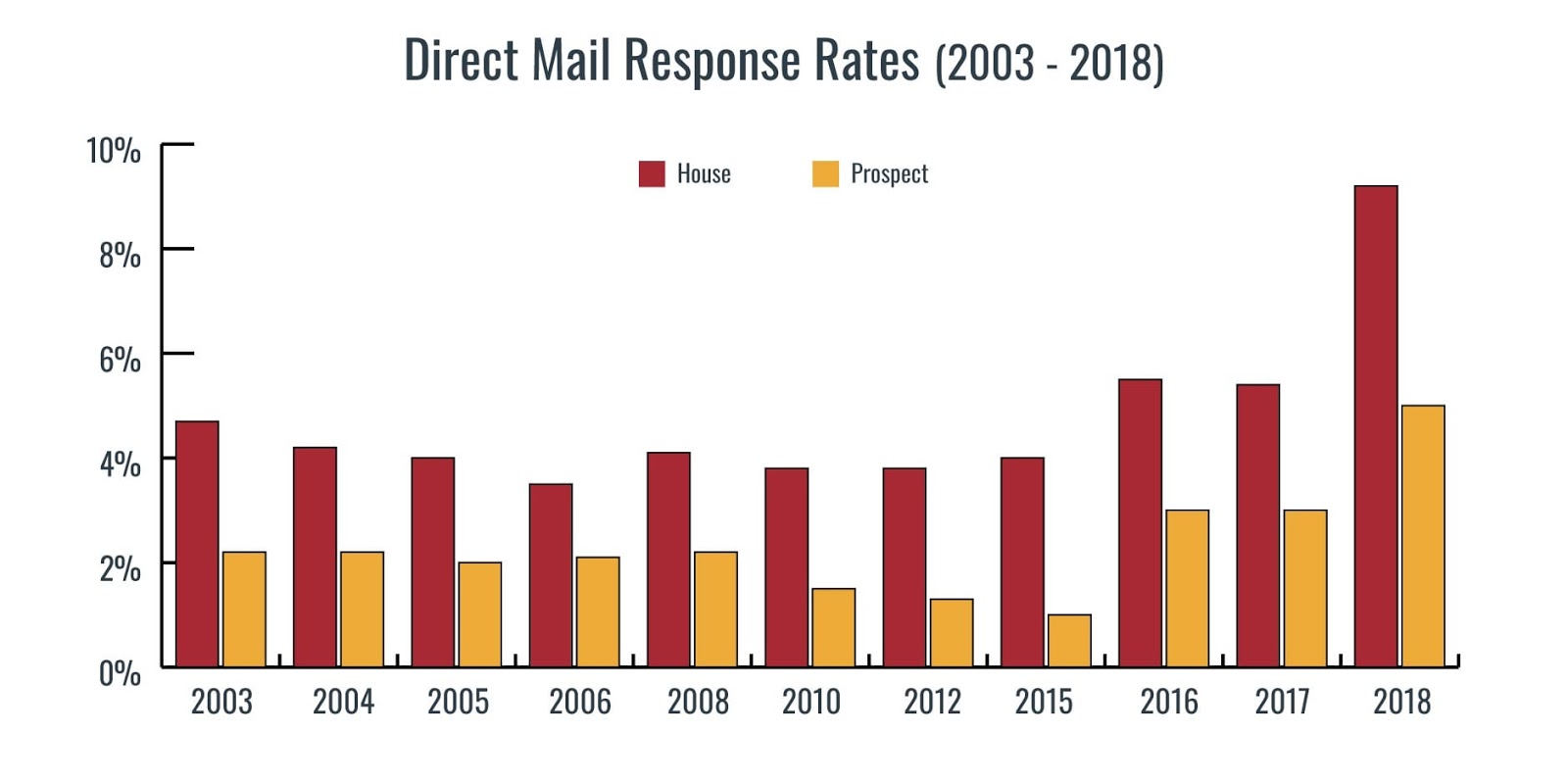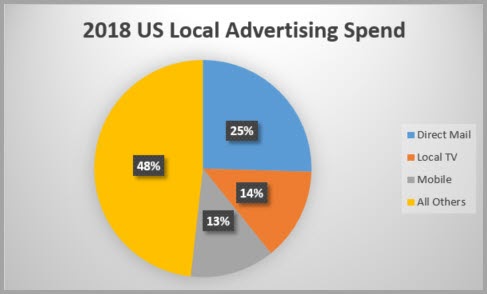
Direct mail marketing has been perhaps the most reliable marketing channel for businesses of all sizes for decades. Recent technology advances have changed the “direct mail how to” to make it far more effective, easy and integrated than the old manual processes marketers used to follow.
Although many predicted that the rise of digital would spell the end of traditional marketing channels, the truth is that we’ve observed the opposite. Today direct mail makes more sense than ever, particularly as technological advances have helped to improve returns and bring it up to speed with its digital counterparts.
Direct mail never went anywhere. It is the consistent workhorse that it always was. But digital trends pushed it from the forefront to the back of the minds of many new-age marketers. For a time, anyway.
In recent years there’s been a resurgence. Take a look at the average response rates per year between 2003-2018, according to a report from the DMA and ANA.

Notice how response rates remained steady or even shrunk in the 2000s as digital continued to expand and play a larger part in the lives of consumers. Then, in the mid-2010s — we see serious growth. Customers are more readily responding to direct mail. Opinions that the channel is antiquated have softened. The tangible, personalized nature of direct mail materials touched an emotional button that digital had been neglecting.
As a result, direct mail marketing is more effective and less competitive than it has ever been.
Learn About COVID Crisis Direct Mail Strategies
This resurgence is due, in part, to the increased competition in digital channels. It also owes some of its growth to the fact that technology has simplified the production, printing, and mailing processes to make this trusted channel more effective and more accessible.
In this article, we’ll cover some of the specific ways that technology has changed the direct mail how to’s, to its benefit.
The Fundamentals Remain Unchanged

While technology may have changed how to do direct mail marketing, that doesn’t mean that prospective senders need to learn everything from the ground up.
The same principles that applied in previous decades to direct mail marketing still, for the most part, apply today. In fact, general marketing best practices and copywriting strategies are still just as effective as they always were.
Good marketing is good marketing. When you have something of value and are able to effectively convey that value to a targeted audience, results will follow.
To digital marketers, direct mail can seem like a whole other world. They might feel like there is a learning curve — best practices to know, differing design trends, size and shipping considerations, etc. — it can feel overwhelming. Marketers with no experience in direct mail may feel like they are behind the curve.
But that’s usually not the case. Yes, there are some things you’ll need to learn. But technology has simplified the entire process from start to finish while ensuring that your direct mail campaigns integrate directly with your digital presence.
If you have the marketing expertise on your team, direct mail marketing should be seen as a ripe opportunity and not a hurdle.
1. Targeted List Building Is Easier (and Better)

In previous years, many marketers would tell you that their biggest direct mail how to struggle was putting together quality lists. Sure, they had their house list of existing customers. That was always a list that they could control.
But companies that wanted to expand their customer base didn’t always have it so easy. Buying lists from third-parties was hit and miss. Who knew how many other businesses were buying the same list? Who knew what kind of quality controls they had in place? That led to a lot of mailpieces never reaching their destination and lower response rates.
But still, the channel was effective enough for companies to look past those issues. It was the norm. Everyone was working with the same tools.
Today, building targeted mailing lists has never been easier. There are so many sources for the data, and many of them have multiple verification and quality control checks in place to ensure that the data is accurate and minimize waste.
Digital tools can build hyper-targeted mailing lists on the fly. In seconds, you can have a list of prospects that match detailed specifications.
2. Automated Production is Faster. Way Faster.

The list of direct mail how to tasks that went into designing, printing, and shipping a campaign used to make it a big commitment for marketers. There were a lot of manual hand offs and moving pieces that went into running a campaign that resonated with your audience.
Direct mail automation changes things. Campaign production processes can be slimmed down, with leaner commitments. With tech advancements, producing direct mail collateral has never been easier.
Here at Postalytics, we offer professional pre-built direct mail templates that you can load and begin editing in seconds. Of course, you always have the option of importing your own original designs. But using Postalytics with the help of a copywriter, you can have your mailer designed and ready to print in minutes, not days or weeks.
Consider all of the processes that this cuts out from your to-do list. First, you have to go through the decision making processes surrounding what you are going to send and to whom. What size of mailpiece would you like to send? What will the design look like?
Then you have to work with designers and copywriters, in tandem, and all of the back-and-forth approval processes that come with it. Depending on the number of stakeholders and the number of revisions and edits that are required, this process alone could have taken weeks.
Modern direct mail tools make the process of designing, copywriting, and producing direct mail campaigns simple.
3. Better Tracking Gives Full Visibility Into Delivery & Response

One of the biggest misconceptions surrounding direct mail marketing is the myth that it is impossible to track delivery or response. That is no longer true.
In years previous, that might have been the case. Or at least it was difficult. You sent out a marketing postcard, then tried to gauge how many responses you received as a result. Those responses might come from direct mail responses, telephone calls, or visits to your store.
A whole lot of manual processes.
It was impossible to know even if your mail was delivered, or when.
When the USPS flagged some of your mail as undeliverable, you’d need to wait for the returned mail to come back to the office, pile up and have someone manually delete addresses from your lists.
Compound the attempts to track traditional direct mail when you throw multiple-touch campaigns in for good measure. Multiple touches work great, but tracking everything could be a nightmare.
Forward-thinking companies used a variety of methods to gauge the returns on their direct mail campaigns, but for the most part, companies were spending a lot of time with manual processes
Still, the channel generated returns that were more than enough to justify the investment.
Modern tools like Postalytics make delivery and response tracking easy with modern campaign dashboards. Just like email and digital marketing tools do.
Delivery tracking is automatically applied to every mailpiece sent through Postalytics. We’ve tapped into the USPS Intelligent Mail Barcode system to enable marketers to understand instantly where exactly there mail is, and specifically which mailpieces are being flagged as undeliverable.
Fully automated response tracking is available via free personalized URLs (pURLs). These tools help you track when individual recipients have engaged with your mailer and gone on to visit your website, using the personalized URL that you included in the mailer.
Further, you can use that tracking data to integrate your direct mail campaigns with your email or digital marketing campaigns.
4. Full Integration With Digital And Email Channels

Another myth that keeps many companies from investing in direct mail marketing is the misconception that the campaigns are on an island, fully disconnected from your other marketing activities.
Now, multi-channel campaigns can easily include the power of print delivered right to the mailbox.
Using Postalytics and other modern direct mail marketing tools you can fully integrate your direct mail campaigns with email or digital campaigns, or even campaigns through other traditional channels.
Postalytics easily integrates with CRM and marketing automation software ensuring that your direct mail campaigns are building on the other activities that you have launched.
This means that direct mail campaigns don’t have to be on an island. They can play a very specific role in processes throughout the funnel and build on and from other messages that your audience has received.
This is critical for a multi-channel approach. Now, transitioning between messaging on your website, social media, email, paid ads, and direct mail can feel seamless, as if they are all a part of the same ongoing conversation.
All of this is powered by data, which is one reason why direct mail integration with other marketing suites is so critical. You want to be able to effectively utilize the data that you have on hand to inform your direct mail campaigns, then use the data generated by those campaigns to inform messaging and approaches on other channels.
5. Opinions on Direct Mail Have Come Full Circle

The rise of digital marketing undoubtedly put channels like direct mail on the backburner for many companies.
The early days of digital marketing were like the Wild Wild West. There were an unending number of opportunities across dozens of channels. Companies that capitalized early were part of a gold rush the likes of which the marketing industry will never see again.
But that timeframe was a short one. Within a few short years, the landscape changed dramatically. Huge B2C and B2B brands increased their focus on digital advertising, bidding up keywords and blasting out emails to huge lists.
This has left many small to mid-sized companies in a tough spot. The digital advertising landscape has become increasingly competitive and difficult for smaller companies that don’t have the budgets for testing or resources to harness their data.
That isn’t to say that digital marketing isn’t effective today. It still is and plays an expanded role in most marketing operations.
But the effect of that was a decrease in competition in more traditional advertising channels — direct mail, billboards, radio ads, etc.
Marketers are increasingly turning to traditional channels, looking for a reprieve from the harsh competition that they deal with online. In direct mail, they found a consistent, reliable channel that customers trust.
In 2018, direct mail made up 25% of the average company’s local advertising spend in the US.

Direct mail delivers a personalized, tangible experience that customers enjoy. It’s one that can’t be replicated in digital campaigns, which is part of the reason why the two make such an excellent pair.
6. Triggered Drip Mail Works For Mid And Late Funnel Campaigns
A big trend that we have seen in the direct mail industry is the shift from batch and blast campaigns to triggered, multi-step campaigns.
Part of the reason for this is the ease of production. It can be less time-consuming to build a four-part mailing sequence today than it was to create a single one-off campaign just a few decades ago.
With direct mail automation, you can send a single piece of targeted, personalized mail to a lead, customer or former customer. There’s no more need to batch up big lists to make direct mail work.

Combined with a CRM or Marketing Automation tool, it is super easy to create and schedule a multi-step drip campaign. This is excellent for nurturing customers, building trust, and growing loyalty among your current customers.
With digital integration, companies can make the delivery of their mailpieces dependent upon other data or actions taken by the customer.
For instance, you could have a direct mail campaign (one-off or multi-step) triggered when a customer visits your website, reads your email, fills out a contact form, or buys a product. The possibilities for creative approaches are endless with trigger and drip campaign automation.
7. A More Personalized Experience for Customers
Today, direct mail campaigns are more personalized than ever before, and 80% of customers are more likely to purchase a product from a brand who delivers a personalized experience.

At a base level, it’s just easier for companies to inject data into their copy. You can easily inject names, addresses, job titles, or other data points directly onto your mailpieces, ensuring that each individual one is unique and personalized for the recipient. You can use pURLs to entice visitors to visit your website and use your data to personalize their experience there as well.
But beyond that, integration with digital channels offers deeper, more detailed personalization. A direct mail campaign becomes one part of an ongoing conversation with every customer and prospect. Triggered campaigns ensure that you are always taking previous interactions and context into account with every direct mail campaign that you send.
Direct Mail is a Channel for Modern Marketers
Direct mail is a consistent and reliable channel for companies in a wide range of industries. Recent advances in tech have truly opened the door for true cross-channel integration from your direct mail campaigns.
It’s never been easier to design, print, and deliver direct mail campaigns while providing a more personalized experience.
If you’d like to learn more how direct mail automation works, check out this quick demo video:
About the Author

Dennis Kelly
Dennis Kelly is CEO and co-founder of Postalytics, the leading direct mail automation platform for marketers to build, deploy and manage direct mail marketing campaigns. Postalytics is Dennis’ 6th startup. He has been involved in starting and growing early-stage technology ventures for over 30 years and has held senior management roles at a diverse set of large technology firms including Computer Associates, Palm Inc. and Achieve Healthcare Information Systems.
